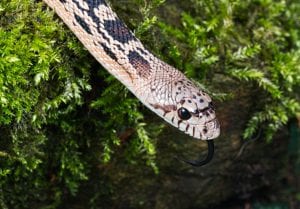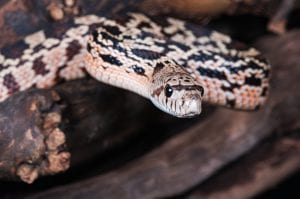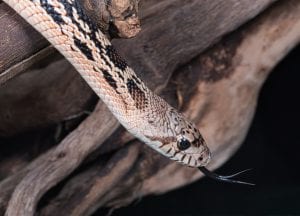There are five sub-species of Pine snakes, all occurring in North America, the Northern Pine snake is the nominate form. It occurs throughout New Jersey, the western Appalachian mountains of Virginia, North Carolina, southern Kentucky, Tennessee, northern Alabama, Northern Georgia, the piedmont area of southern North Carolina and nearly all of South Carolina. Often found in  upland, sandy, dry coniferous woodland, mainly pine, and usually in forest openings. It has a large developed rostral plate on the tip of its nose that allows the snake to burrow in the sandy conditions – mainly to escape the hot summer temperatures. It is one of the largest North American snakes at around 2m in length. Often has an irritable nature, huffing and puffing, mouth agape in a typical (for the species) “s” shape. It also rattles its tail, and all of this defence is very similar to a Rattlesnake. The would naturally bromate (hibernate) for around three months in the winter to escape the cooler temperatures during the winter, and breeds in the spring.
upland, sandy, dry coniferous woodland, mainly pine, and usually in forest openings. It has a large developed rostral plate on the tip of its nose that allows the snake to burrow in the sandy conditions – mainly to escape the hot summer temperatures. It is one of the largest North American snakes at around 2m in length. Often has an irritable nature, huffing and puffing, mouth agape in a typical (for the species) “s” shape. It also rattles its tail, and all of this defence is very similar to a Rattlesnake. The would naturally bromate (hibernate) for around three months in the winter to escape the cooler temperatures during the winter, and breeds in the spring.
A large vivarium is required for this species, a four feet long vivarium for an adult is the minimum size required. Hatchlings often do better in much smaller vivaria. Although not essential for successful maintenance a deep layer of substrate will allow for natural burrowing behaviour.  Hides, branches and a water bowl are all required.
Hides, branches and a water bowl are all required.
Heating and lighting can be provided in several ways, with much debate as to which is the “acceptable” method. In a more “sterile” vivarium a heat mat mounted underneath the vivarium (glass or plastic only, don’t try this with a wood/melamine vivarium) mimics their natural need for belly heat – however in a more elaborate vivarium set up with deep layers of substrate this is totally unsuitable. A better method for heating this set up would be an overhead heater such as a ceramic or incandescent bulb heater, perhaps with a piece of flat rock or slate that warms up underneath. Lighting, again, is debatable – the species has been successfully kept and bred with no  UVB lighting for many years – however for those that aim to provide as natural conditions as possible a {cb5d0a8cf0c44aef2db327d9ab0dba08dd09aed1126b509e5fa01d3aaa87fe47}6 UVB fluorescent tube is becoming the norm.
UVB lighting for many years – however for those that aim to provide as natural conditions as possible a {cb5d0a8cf0c44aef2db327d9ab0dba08dd09aed1126b509e5fa01d3aaa87fe47}6 UVB fluorescent tube is becoming the norm.
This species is perhaps best suited to those keepers with more experience due to their larger size and irritability. However they are a fascinating species, worthy of a place in any keepers collection.
